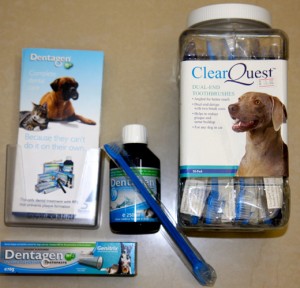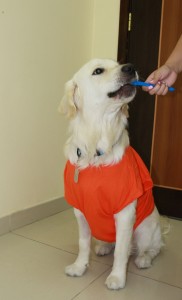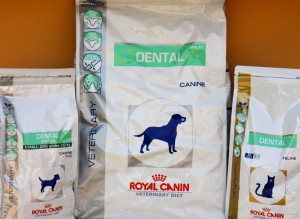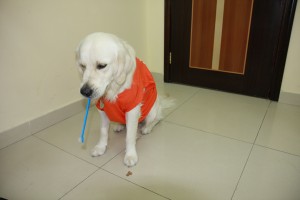
Imagine what your mouth would feel like if you never brushed your teeth or went to the dentist. For many dogs and cats, this is a painful reality. According to the Veterinary Dental Society, more than 80% of dogs and 70% of cats have dental disease by the age of 3 years. Dental (or periodontal) disease is the most frequently diagnosed health problem in pets.
Common signs of dental disease include:
- Yellow or brown buildup (tartar) on the teeth
- Red, swollen, or bleeding gums
- Bad breath
- Excessive drooling
- Changes in eating or chewing habits
- Pawing at the face
- Loose teeth
- Depression
- Weight loss
 Even if your dog or cat doesn’t have these symptoms, we recommend that you have a veterinarian evaluate your pet’s dental health at least once a year. Bacteria and food debris accumulate around the teeth and, if left unchecked, will lead to deterioration of the soft tissue and bone surrounding the teeth. This decay can result in irreversible periodontal disease, tooth loss, and possibly expensive oral surgery.
Even if your dog or cat doesn’t have these symptoms, we recommend that you have a veterinarian evaluate your pet’s dental health at least once a year. Bacteria and food debris accumulate around the teeth and, if left unchecked, will lead to deterioration of the soft tissue and bone surrounding the teeth. This decay can result in irreversible periodontal disease, tooth loss, and possibly expensive oral surgery.
Dental disease can also affect other organs in the body: Bacteria in the mouth can get into the bloodstream and cause serious infections in the kidneys, liver, lungs, and heart. If these problems aren’t caught and treated quickly enough, they can result in death. A physical exam combined with appropriate laboratory work can determine if infection in the mouth has spread. Pets require professional dental cleaning even more than we do, as they are not able to brush their teeth three times a day.
With every physical examination, including when your pet comes in for vaccinations, our veterinarians at CVH will examine your pet’s oral cavity and discuss with you their findings, and recommendations.
Schedule your pet’s dental exam today! We can also show you how to brush your pet’s teeth and recommend foods and treats that will help combat oral discomfort, that occur with plaque and tartar buildup.
For pets who already have dental pain and disease, we may recommend a proper dental cleaning. This is the same procedure as we have at our dentist once or twice a year. The difference in pets is our inability to effectively communicate to them, why they must fully open their mouth while we use instruments, make noise and use the same high tech equipment as our dentist does. We therefore must give them an anesthetic to properly clean and scale the inside surfaces of their teeth, check the gums and most especially avoid them moving with instruments in their mouths. As with any anesthetic we first do a full physical exam, check their blood work, put them on IV fluids and intubate them for the procedure.  Intubation protects their airway, as we can not tell them to rinse their mouths and spit out the water and debris, as we would while at our dentist. We thoroughly check all of their teeth, take x-rays when necessary, clean and polish their teeth, and conduct a thorough oral exam of the tongue, gums and roof of the mouth.
Intubation protects their airway, as we can not tell them to rinse their mouths and spit out the water and debris, as we would while at our dentist. We thoroughly check all of their teeth, take x-rays when necessary, clean and polish their teeth, and conduct a thorough oral exam of the tongue, gums and roof of the mouth.
Please feel free to discuss the type of dental care your pet requires with our team. We always advise as much home care as possible, by way of brushing, rinses, treats and diets to decrease the frequency of full dental cleanings! Brushing alone will not take away years of plague and bacteria build up, however brushing and home care will really benefit your pet once their mouth is clean and pain free!











